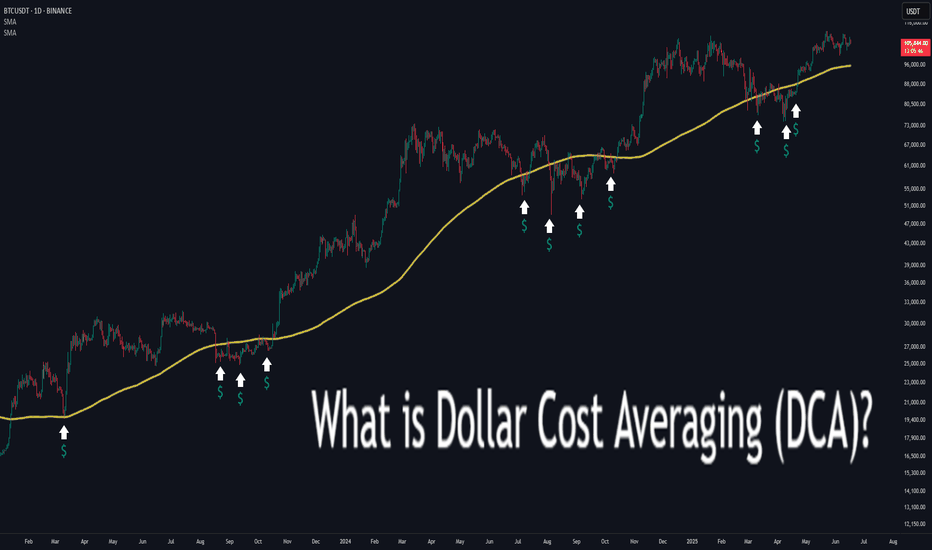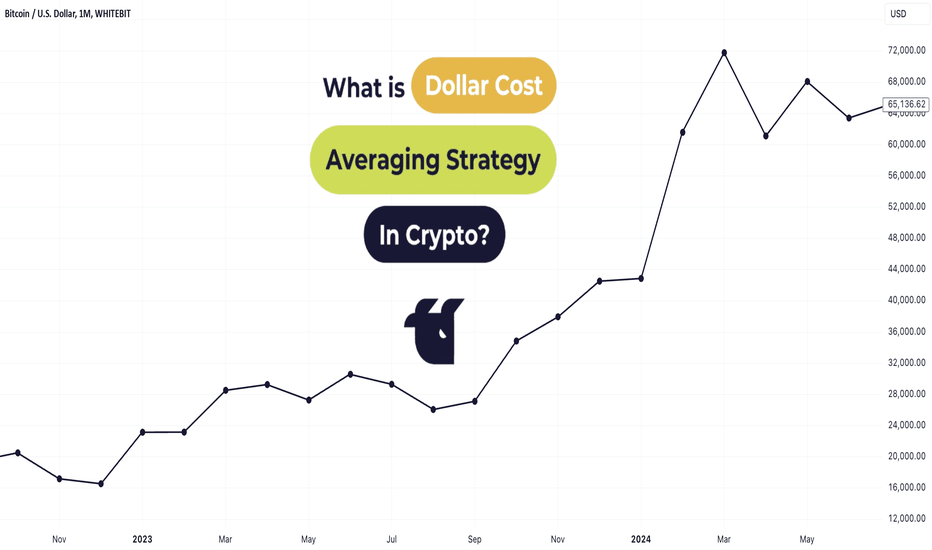What is Dollar Cost Averaging (DCA)?🔵 What is Dollar Cost Averaging (DCA)?
Dollar Cost Averaging (DCA) is a timeless investment strategy that involves investing a fixed amount of money at regular intervals, regardless of the asset's price. It’s one of the most effective ways to build a position over time while minimizing the impact of market volatility.
The term "Dollar Cost Averaging" was popularized in the early 20th century by Benjamin Graham — the father of value investing and mentor to Warren Buffett. Graham advocated DCA as a way to remove emotions and guesswork from investing. By spreading out purchases, investors could avoid mistiming the market and reduce risk exposure.
Today, DCA remains a core strategy for retail investors, especially in volatile markets like cryptocurrencies and growth stocks.
🔵 How Does DCA Work?
The concept is simple: instead of investing a lump sum all at once, you break your total investment into smaller, equal parts and invest them over time — for example, weekly or monthly.
Invest $100 every week into Bitcoin.
Keep buying consistently — regardless of whether price goes up or down.
Over time, this smooths out your average entry price.
You buy more when price is low, and less when price is high.
Example:
If BTC is at $30,000 one month, you buy a small amount.
If BTC drops to $25,000 the next month, you buy more units with the same $100.
Over time, your entry price averages out — reducing the risk of buying at a peak.
🔵 Why Use DCA?
DCA offers both psychological and mathematical advantages:
Reduces timing risk: You don’t need to predict market tops or bottoms.
Builds discipline: Encourages consistent investing habits.
Prevents emotional mistakes: Avoids FOMO buying and panic selling.
Smooths volatility: Especially useful in crypto or fast-moving assets.
🔵 Smart DCA: Buying Into Market Bottoms
While classic DCA is powerful on its own, it becomes even more effective when combined with market structure. A popular approach is to only DCA when the asset is trading below its long-term average — such as the 200-day Simple Moving Average (SMA) or using RSI (Relative Strength Index).
What is the 200-day SMA?
It’s the average closing price over the last 200 days — a key indicator of long-term trend direction.
Why DCA Below the 200 SMA?
Historically, many market bottoms occur below the 200 SMA. Using this as a filter helps you avoid accumulating during overvalued or overheated conditions.
SDCA with RSI
The Relative Strength Index (RSI) helps identify momentum exhaustion. When RSI drops below 30, it often marks deeply oversold conditions — especially on the daily chart for BTC.
How to use it:
Only DCA when price is below the 200-day SMA.
You accumulate during crashes, fear, and corrections.
Avoid buying when price is extended far above long-term value.
🔵 Scaling DCA Based on Undervaluation
To further optimize the strategy, you can scale your DCA amounts depending on how far below the 200 SMA the price is.
Example:
Price is 5% below 200 SMA → invest normal amount.
Price is 15% below → double your investment.
Price is 25% below → triple your investment.
This creates a dynamic DCA system that responds to market conditions — helping you build larger positions when prices are truly discounted.
🔵 When DCA Doesn’t Work
Like any strategy, DCA has limitations. It’s not magic — just a system to reduce timing errors.
In strong uptrends, a lump sum investment can outperform DCA.
In declining assets with no recovery (bad fundamentals), DCA becomes risky.
DCA works best on quality assets with long-term growth potential.
Always combine DCA with research and risk management — don’t blindly accumulate assets just because they’re down.
🔵 Final Thoughts
Dollar Cost Averaging isn’t about buying the exact bottom — it’s about consistency , discipline , and risk control . Whether you’re investing in Bitcoin, stocks, or ETFs, DCA offers a stress-free approach to enter the market and smooth out volatility over time.
Smart traders take it one step further: using moving averages and structure to focus their DCA efforts where value is highest.
DCA won’t make you rich overnight — but it will help you sleep at night.
This article is for educational purposes only and is not financial advice. Always do your own research and invest responsibly.
Dcainvesting
Dollar-Cost Averaging: The Simple Strategy Every Trader NeedsHello, Traders! 👋🏻
Timing the market is one of the most complicated challenges for any trader. The constant question of “Is this the right time to buy?” or “Should I wait for a better price?” creates hesitation and often leads to missed opportunities – or worse, emotional decisions.
That’s where Dollar Cost Averaging (DCA) comes in. DCA meaning? Rather than trying to predict market movements, DCA takes a disciplined, consistent approach to investing. By committing to regular investments over time, you smooth out the highs and lows, removing the stress of decision-making and allowing you to build your portfolio steadily.
In this article, we’ll dive into how DCA works, why it’s an effective strategy, and how to use it to stay in control. 🧘🏻
Why Is Market Timing So Hard (and How Does DCA Solve It)? What is Dollar Cost Averaging?
The allure of perfectly timing the market is strong. Who wouldn’t want to buy at the absolute bottom and sell at the peak? But the reality is that market timing typically turns into guesswork. Even with technical analysis, factors like sudden news events, regulatory changes, or shifts in market sentiment can make predictions unreliable. This uncertainty is especially true in the crypto industry, where prices can swing dramatically within hours. For many traders, this indecision can lead to two common pitfalls:
⏰Waiting Too Long. Hoping for a better entry point that never comes, missing out on gains.
😬Jumping in Emotionally. Chasing the market during a rally or panicking during a dip, only to see prices reverse shortly after.
Dollar Cost Averaging sidesteps all of this. Instead of trying to outsmart the market, you invest a fixed amount regularly – whether prices are up, down, or sideways. It’s a simple, effective way to participate in the market without letting emotions or second-guessing hold you back. Just strategy. Nothing extra. 🤷🏻
So, What’s the Secret? How DCA Works in Practice? DCA Investing
Commit to a Fixed Amount
With DCA crypto, you decide how much to invest each time – say, $100 weekly or $500 monthly. This amount stays consistent, no matter what the market is doing.
Stick to a Schedule
Regularity is key. By investing in a schedule (e.g., every Friday or the 1st of each month), you eliminate the need to decide when to enter the market.
Take Advantage of Volatility
When prices 📉, your fixed investment buys more of the asset. When prices rise, it buys less. Over time, this helps reduce your average cost, giving you an edge in volatile markets.
Use Auto-Investing Tools
Many crypto exchanges offer auto-investing features , making setting up and sticking to your DCA strategy easier. With these tools, you can automate recurring purchases of your chosen asset at regular intervals (weekly, biweekly, or monthly). All you need to do is select the asset, set the amount, and schedule the frequency. Once configured, the platform handles the rest, eliminating the risk of forgetting or deviating from your plan.
Example:
Imagine you’re investing $200 into Bitcoin (BTC) every 2 weeks.
Bitcoin DCA Example:
After 5 cycles, you’ve invested $1,000 and accumulated approximately 0.05 BTC at an average cost of $20,000—lower than the highest price during this period.
The Key Benefits of DCA
Soooo… Why is DCA a go-to strategy for many traders?
DCA removes the stress of guessing when to buy. You follow a plan and let the strategy do the work.
By investing during both highs and lows, your average cost tends to decrease over time.
Fear and Greed are the biggest enemies of consistent gains. DCA automates your investments, helping you avoid emotional decisions that could harm your portfolio.
Whether you’re buying Bitcoin, Ethereum, or even traditional assets like ETFs, DCA adapts to your goals and market preferences.
Regular investing instills good habits, encouraging you to focus on the long-term growth of your portfolio.
In conclusion, the markets will always have ups and downs, but with DCA, you don’t have to worry about catching every wave 🏄. Instead, you focus on building your portfolio steadily, one step at a time.

